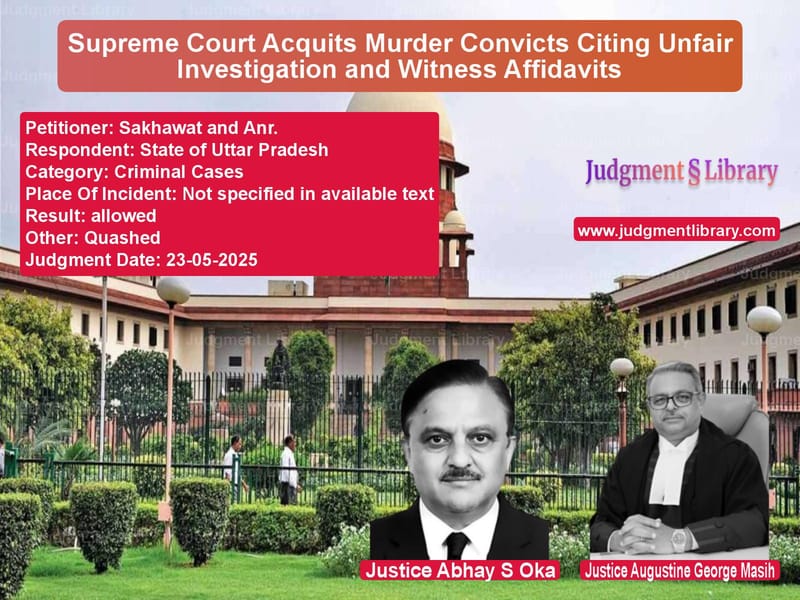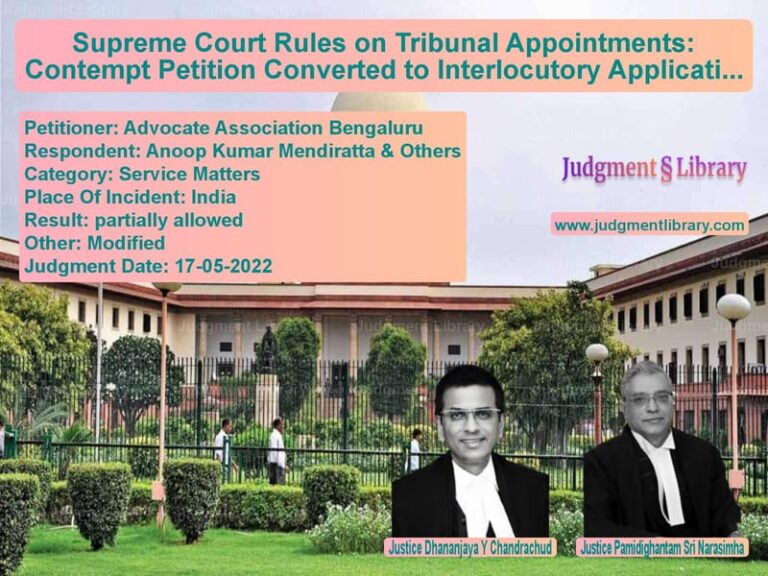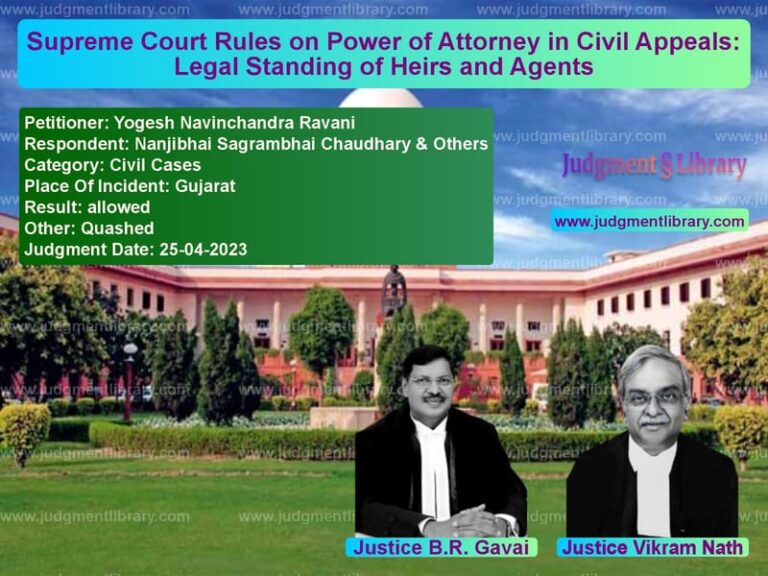Supreme Court Acquits Murder Convicts Citing Unfair Investigation and Witness Affidavits
In a landmark judgment that underscores the importance of fair investigation and the right to a fair trial, the Supreme Court of India has acquitted two men who were convicted for murder and sentenced to life imprisonment by the trial court and high court. The case, which dates back to a 1981 night-time shooting, reveals crucial flaws in police investigation and raises serious questions about witness testimony that changed dramatically between bail hearings and trial.
The incident occurred on the intervening night of May 4-5, 1981, when Sukha was shot dead in his hut and a woman named Nanhi (PW-7) was injured with both gunshot and knife wounds. According to the prosecution, the murder was motivated by an alleged illicit relationship between the deceased and PW-7, who happened to be the sister of the accused persons. The prosecution claimed that the accused—Sakhawat (appellant no. 1), Mehndi (appellant no. 2), and Abrar (accused no. 1)—confronted the couple in the deceased’s hut, resulting in the fatal shooting and injuries to PW-7.
The prosecution built its case primarily on the testimony of four eyewitnesses: PW-4 (Amir Hussain, the first informant), PW-5 (Allah Baksh), PW-6 (Mohd. Hanif, son of PW-5), and PW-7 (Nanhi, the injured woman). The trial court in 1982 convicted Sakhawat and Mehndi, sentencing them to life imprisonment while acquitting Abrar. The High Court later confirmed this conviction, leading to the appeal before the Supreme Court.
The Defense’s Arguments
The appellants’ senior counsel raised several crucial points that would ultimately prove decisive. He highlighted that “both PW-5 (Allah Baksh) and PW-6 (Mohd. Hanif) had sworn affidavits at the time of consideration of bail applications of the appellants. Those affidavits were in favour of the accused.” Though both witnesses denied having filed such affidavits during cross-examination, the defense presented witnesses to prove that these affidavits were indeed filed.
The defense also pointed to inconsistencies in the prosecution’s case, noting that “although the incident occurred at 2:00 am on 5th May 1981, the FIR was lodged only at 6:30 am.” This delay, along with other procedural lapses, created doubt about the veracity of the prosecution’s version. The defense further argued that “the recovery of articles (weapons of offence) was not proved” and that the Forensic Science Laboratory Report was not placed on record.
The Prosecution’s Position
The State’s counsel defended the convictions, arguing that “the evidence of PW-5 and PW-6, which clearly ascribes roles to the appellants, has gone unchallenged as there was neither any material contradiction nor any omission brought on record.” He emphasized that “even evidence of PW-4 is reliable and deserves acceptance” and pointed out that PW-7 had turned hostile, so her evidence should be kept out of consideration.
The State also stressed that there were “concurrent findings of fact by both the Trial Court and the High Court” and in the absence of any perversity in these findings, there was no reason for the Supreme Court to interfere.
The Supreme Court’s Critical Findings
The Supreme Court, after carefully examining the evidence, uncovered a crucial aspect that both lower courts had overlooked. The Court found that during bail proceedings, three key prosecution witnesses—PW-5, PW-6, and PW-7—had filed affidavits stating that the appellants were not the culprits. The Sessions Court had actually granted bail to the accused based on these very affidavits.
The Court noted with concern that the Investigating Officer, when confronted about these affidavits during cross-examination, gave unsatisfactory answers. When asked why he didn’t file a counter-affidavit to these witness affidavits, the IO stated: “Witnesses were not found available to me as such I could not verify as to whether they had filed affidavits or not and on account of this reason I could not file any counter-affidavit also.”
When further questioned about his efforts to locate these witnesses, the IO responded: “I had gone personally” but admitted he had “not recorded anything in case diary about searching witnesses for counter-affidavit” and had “closed case diary after completing investigation.”
The Court strongly criticized this failure to investigate the contradictory affidavits, stating: “Thus, the fact that PW-5 and PW-6 had submitted the affidavits in the bail application in favour of the accused is admitted by the investigating officer. Even the affidavit of PW-7 (Nanhi) is admitted. Though there is a defence evidence adduced to prove the execution of the affidavits by PW-5 and PW-6, marked as Annexure ‘A’ and ‘B’, the police did not conduct an investigation by sending the affidavits and admitted thumb impressions of the witnesses for examination by an expert.”
Read also: https://judgmentlibrary.com/supreme-court-corrects-typographical-error-in-criminal-case-judgment/
The Fundamental Right to Fair Investigation
The Court emphasized the constitutional dimensions of the case, noting: “Under Article 21 of the Constitution of India, the accused is entitled to a fair trial. Even the Police are under an obligation to carry out a fair investigation. This is a crucial aspect of fairness. The objective of the investigation is to ensure that the real culprits are brought to justice. The legal system must ensure that an innocent person is not punished.”
The judgment highlighted that “by failing to carry out further investigation on the basis of the said affidavits, the prosecution has failed to carry out a fair investigation. Moreover, the prosecution tried to suppress the affidavits.”
The Court expressed serious concerns about the credibility of the witnesses, observing that “there is a serious doubt created about the truthfulness of the versions of PW-5 to PW-7 before the Court. It is pertinent to note that PW-5 was detained at the police station for 24 hours before his statement was recorded. A serious doubt is created whether these witnesses are telling the truth.”
The Court’s Final Ruling
In its concluding analysis, the Court stated: “Therefore, this is a case where there is failure on the part of the High Court and the Session Court to consider the cross-examination of PW-10 and the suppression of the affidavits by the prosecution. These highly relevant aspects have been completely overlooked by the High Court.”
The Court ultimately held that “as the prosecution has not conducted a fair investigation and has suppressed important material in the form of affidavits of PW-5 to PW-7, it is unsafe to convict the appellants only on the basis of the testimony of PW-4.”
Before concluding, the Court made an important observation about judicial language, reiterating “the direction issued in the order dated 8th February 2024, that the record of the Trial Court should not be referred to as ‘Lower Court Record’. Describing any Court as a ‘Lower Court’ is against the ethos of our Constitution.”
The Supreme Court allowed the appeal, set aside the convictions, and acquitted both appellants. The judgment serves as a powerful reminder that procedural fairness and thorough investigation are not mere technicalities but essential components of justice delivery. When the investigation itself is flawed and potentially manipulated, the entire foundation of the prosecution case becomes suspect, regardless of how convincing the surface narrative might appear.
Petitioner Name: Sakhawat and Anr..Respondent Name: State of Uttar Pradesh.Judgment By: Justice Abhay S Oka, Justice Augustine George Masih.Place Of Incident: Not specified in available text.Judgment Date: 23-05-2025.Result: allowed.
Don’t miss out on the full details! Download the complete judgment in PDF format below and gain valuable insights instantly!
Download Judgment: sakhawat-and-anr.-vs-state-of-uttar-prade-supreme-court-of-india-judgment-dated-23-05-2025.pdf
Directly Download Judgment: Directly download this Judgment
See all petitions in Murder Cases
See all petitions in Bail and Anticipatory Bail
See all petitions in Attempt to Murder Cases
See all petitions in Custodial Deaths and Police Misconduct
See all petitions in Fraud and Forgery
See all petitions in Judgment by Abhay S. Oka
See all petitions in Judgment by Augustine George Masih
See all petitions in allowed
See all petitions in Quashed
See all petitions in supreme court of India judgments May 2025
See all petitions in 2025 judgments
See all posts in Criminal Cases Category
See all allowed petitions in Criminal Cases Category
See all Dismissed petitions in Criminal Cases Category
See all partially allowed petitions in Criminal Cases Category







